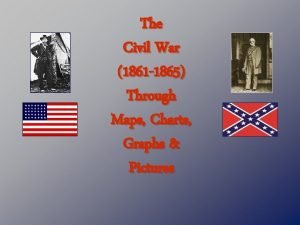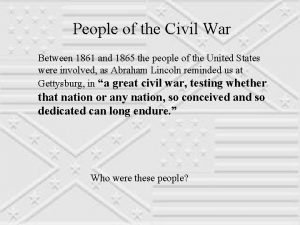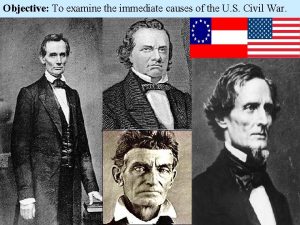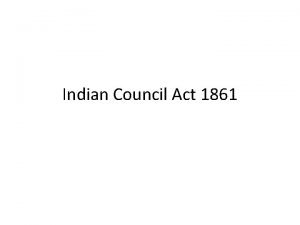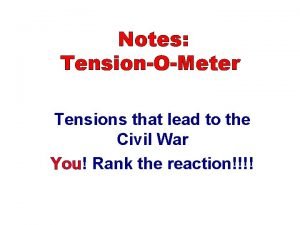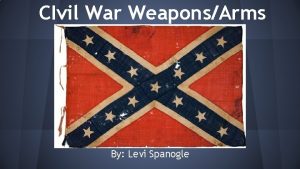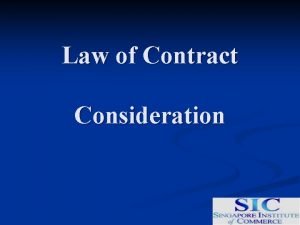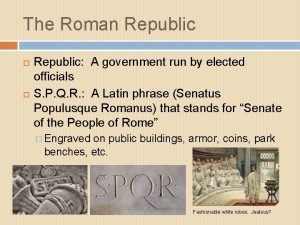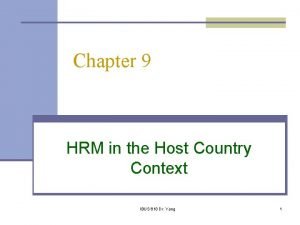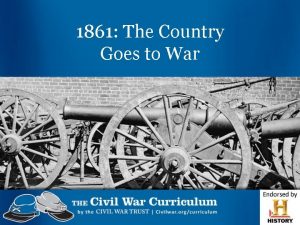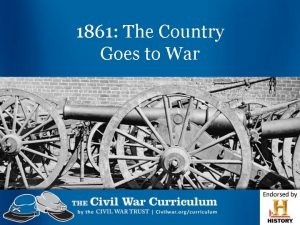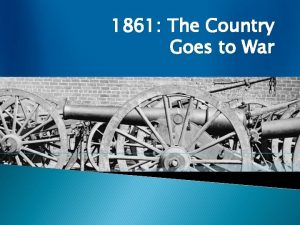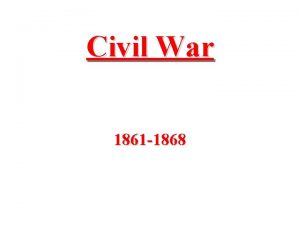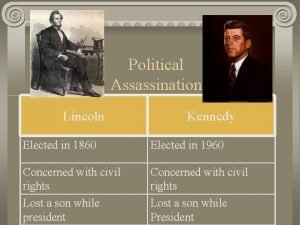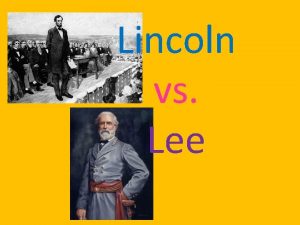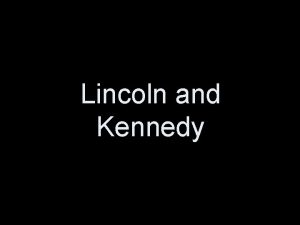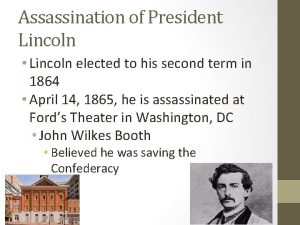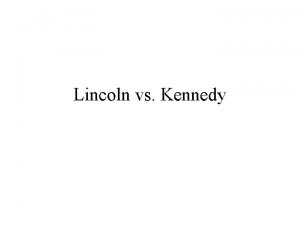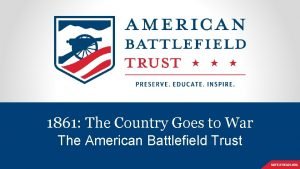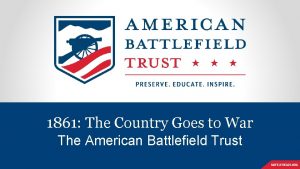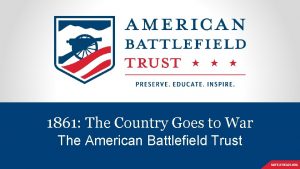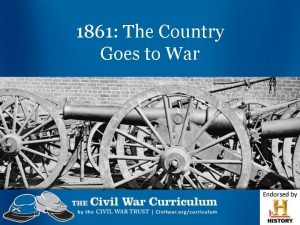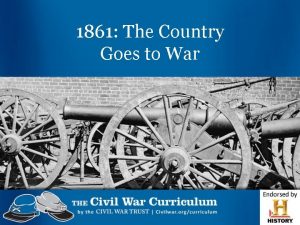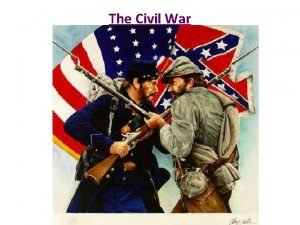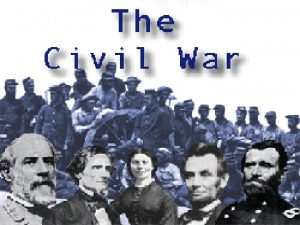1861 The Country Goes to War Lincoln Elected



















- Slides: 19

1861: The Country Goes to War

Lincoln Elected President November 6, 1860 Red – Lincoln Yellow – Bell Blue – Douglas Green – Breckinridge Purple – Non-Voting Territories

Lincoln Elected President In the 1860 presidential race, four men ran for president – a northern Democrat, a southern Democrat, an independent, and Lincoln, a republican. Due to the choice of 4 candidates, Lincoln, carrying the votes of the populous North, won. Southerners became very fearful that the anti-slavery Republicans would try to change their way of life.

Excerpt, Civilian And Gazette Weekly November 13, 1860, Galveston, Texas The Governor [of South Carolina], “earnestly recommended that, in the event of Abraham Lincoln’s election to the Presidency, a convention for the people of this State be immediately called to consider and determine for themselves the mode and measure of redress. ” The Governor said: "That the only alternative left, in my judgment, is the secession of South Carolina from the Federal Union. The indications of many of the Southern States justify the conclusion that the secession of South Carolina would be immediately followed, if not adopted simultaneously, by them, and ultimately by the entire South…. The State has, with great unanimity, declared that she has the right peaceably to succeed, and no power on earth can rightfully prevent it. ”

Excerpt, First Inaugural Address Abraham Lincoln, President of the United States of America “In your hands, my dissatisfied fellow -countrymen, and not in mine, is the momentous issue of civil war. The Government will not assail you. You can have no conflict without being yourselves the aggressors. You have no oath registered in heaven to destroy the Government, while I shall have the most solemn one to ‘preserve, protect, and defend it. ’”

Excerpt, Declaration of the Immediate Causes Which Induce and Justify the Secession of South Carolina from the Federal Union “A geographical line has been drawn across the Union, and all the States north of that line have united in the election of a man to the high office of President of the United States, whose opinions and purposes are hostile to slavery. He is to be entrusted with the administration of the common Government, because he has declared that "Government cannot endure permanently half slave, half free, " and that the public mind must rest in the belief that slavery is in the course of ultimate extinction. The guaranties of the Constitution will then no longer exist; the equal rights of the States will be lost. The slaveholding States will no longer have the power of self-government, or self-protection, and the Federal Government will have become their enemy. ”

Secession of South Carolina December 20, 1860 • On December 20, 1860 South Carolina formally seceded from, or left the Union. • South Carolina based this action on the basis of states’ rights, which they felt the new President, Abraham Lincoln, would violate. • Within the next six weeks, six other states voted to secede. The Confederate States of America was established.

South Carolina Secedes December 20, 1860

Secession January & February, 1861

A President for the Confederacy February 9, 1861 Jefferson Davis is chosen as the President of the Confederate States of America. He will be elected that November.

Fort Sumter April 12, 1861 Located off the coast of South Carolina, Confederate forces fired on the fort, which was unable to effectively fight back. The United States surrendered Fort Sumter, Union forces left the following day. The firing upon Fort Sumter was the opening engagement of the American Civil War.

Excerpt, Surrender of Fort Sumter Effect of the News at Richmond April 15, 1861, Richmond Enquirer The procession had swelled to about three thousand persons, by the time the column halted at the Tredegar Iron Works, to witness the raising of a large Southern Confederacy flag over the main building of the works, which was done by the employees of the establishment. Without delay, the flag was hauled up, the band playing the Marsellaise, and cannon (manufactured at the Tredegar for the use of the Confederate Government) thundered a welcome to the banner of the South.

Secession April & May, 1861

Virginia Joins the Confederacy April 17, 1861 • Virginia joins the Confederate States of America. • Richmond becomes the Capital of the Confederacy

Excerpt from the Inaugural Address Jefferson Davis, President of the Confederate States of America “I enter upon the duties of the office to which I have been chosen with the hope that the beginning of our career as a Confederacy may not be obstructed by hostile opposition to our enjoyment of the separate existence and independence which we have asserted, and, with the blessing of Providence, intend to maintain. Our present condition, achieved in a manner unprecedented in the history of nations, illustrates the American idea that governments rest upon the consent of the governed, and that it is the right of the people to alter or abolish governments whenever they become destructive of the ends for which they were established. ”

First Manassas (Bull Run) July 21, 1861 The first major land battle of the American Civil War, The Battle of First Manassas, also known as Bull Run, was fought just outside of Washington D. C.

First Manassas: Battle of Bull Run

Results: • Both sides entered the battle with confidence. North planned on victory and then a march to Richmond, to surround the Confederate Capitol • Both sides had spectators…including families with picnic baskets! • Rose Greenhow had spied and given southern generals the plans for northern invasion • Union made early gains, but in the end, the Union was forced to flee back to Washington, DC • Confederate General Thomas “Stonewall” Jackson earns his nickname that afternoon (arrived late with additional troops) • ENDING THE REBELLION WOULD NOT BE EASY- Lincoln said, “It’ll be a long and costly affair. ”

Excerpt, The New York Times July 26, 1861, New York Governor Morgan, it will be seen by his Proclamation, published in another column, has concluded, under the requisition of the President for more troops, to call for twenty-five thousand additional Volunteers, to serve for three years, or during the war. It is expected at Fortress Monroe that Magruder, the rebel commander at Yorktown, emboldened by the success at Manassas Junction will make a demonstration in the direction of Hampton or Newport News. All our regiments there are now inside their entrenchments, and ready for him whenever he chooses to show himself.
 Civil war 1861/1862
Civil war 1861/1862 Civil war 1861/1862
Civil war 1861/1862 Edward baker lincoln
Edward baker lincoln South carolina 1861
South carolina 1861 Indian councils act 1861
Indian councils act 1861 South carolina 1861
South carolina 1861 Unionistička stranka 1861
Unionistička stranka 1861 Springfield model 1861 rifle facts
Springfield model 1861 rifle facts England v davidson (1840)
England v davidson (1840) Simple democracy definition
Simple democracy definition When and why was ross barnett elected governor?
When and why was ross barnett elected governor? Elected only by plebeians, veto power, 1 year term
Elected only by plebeians, veto power, 1 year term Where was the first fbla chapter located
Where was the first fbla chapter located An elected official in rome
An elected official in rome Intra country vs inter country
Intra country vs inter country Host country and home country
Host country and home country Toward civil war lesson 3 secession and war
Toward civil war lesson 3 secession and war The cold war lesson 1 the cold war begins
The cold war lesson 1 the cold war begins Balanced force
Balanced force Cold war proxy wars
Cold war proxy wars
